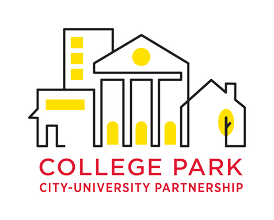Transforming College Park: Eras in Place
I recently had the pleasure of speaking with a University of Maryland class about the Partnership and our work in College Park. This was an impressive group of students learning about civic engagement — spending hours of extracurricular time attending local community meetings in College Park and all along the Route 1 corridor. We discussed physical changes underway in the city, housing needs, and existential concerns such as climate change. Towards the end of class, one student asked pointedly, “do you think that our college experiences will be negatively impacted by the extreme amount of construction taking place on campus and in the community?” After a brief moment of reflection, I assured the student I didn’t think it would. Learning and connecting with peers can take place in many different locations and contexts, and – as we’ve learned in the past three years – are not necessarily predicated on place.
However, the student’s question definitely got me thinking meaningfully about the relationship of place not only to students’ experiences but of residents and communities over time. How can places play into broader community narratives, particularly in college towns like College Park?
As you will read in this month’s bulletin, College Park transformed over the last century, evolving from a quaint early-20th century streetcar suburb into the thriving, dynamic, community we know today. Its urban form has changed over time, closely reflecting the growth of the University of Maryland, the area’s largest institution and employer. College Park is a city of neighborhoods, whether they be historic or more recently built. Its main street and downtown have always been defined by Route 1, a state highway most recently associated with heavy traffic, and aging strip retail and commercial buildings.


College Park has always had a unique character. However, in recent years new investment and development have initiated a revitalization process with the goal of becoming one of the top American city-university communities in the 21st century. It’s an ambitious goal, and in 2019, the Partnership led a visioning process with community stakeholders, the City of College Park and the University of Maryland to establish a shared vision for the future, building on its past and strategically transforming its built environment to meet today’s priorities. The result of this process – Vision 2030 – lays out an ambitious set of shared goals that seek to balance the complexities inherent in the changing College Park’s physical form to meet the needs of today while not losing its unique sense of place.
In this month’s bulletin, we’re focusing on a selection of the transformations College Park has seen over time. We’re diving into the past while taking stock of where the city is now. As I read through this month’s articles, I’m struck by how many perspectives there are (even amongst our team) of a place we all share – perspectives on where the city is coming from and where it’s headed in the future. How can we create meaningful, shared spaces in College Park for residents? What does it mean to be a great place? What stories can we share about College Park’s past that inform its future?
And most pressing, how can we ensure that College Park’s physical transformation addresses the urgencies of the 21st century – climate change, social equity, racial justice – while retaining its unique character and sense of place?
It’s an exciting time. Transformation is underway, and our work to realize the collective vision for College Park is ongoing. Together with our partners at the City and University, we are working to enhance neighborhoods, encourage economic growth and ensure that College Park is a place where everyone can thrive. Change can be challenging, but it can also be hugely rewarding. We have a lot of work ahead of us!
